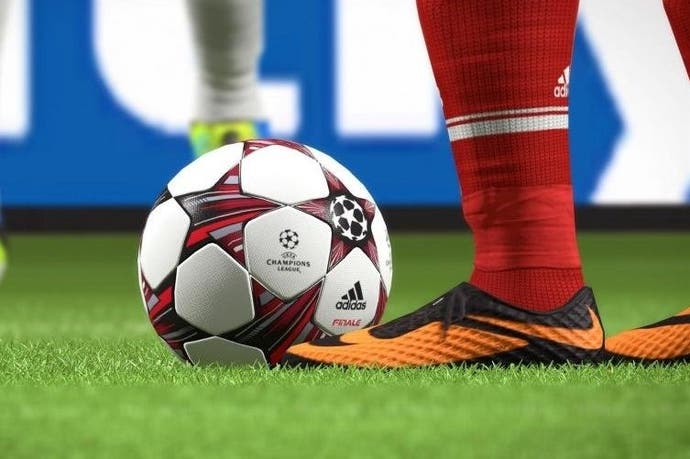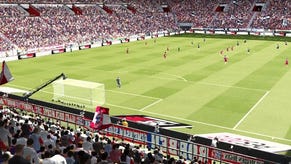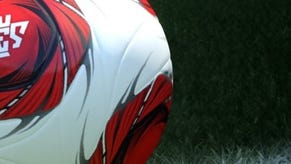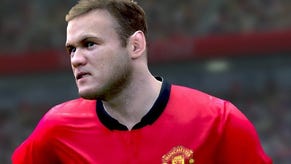Konami takes aim at Ultimate Team with PES 2015
New myClub mode combines random signings with microtransactions, hopes for profit.
Listen carefully. We may need science fiction sound effects.
It is the year 2020 (*pew* *pew* *pew*). Crystal Palace are winners of the double-treble, and lead the English first division by a commanding 13 points. Their big star - among a firmament of stars that includes Neymar, Iniesta and, um, Zlatko Junuzović - is Dirk Kuyt, reincarnated as a preternaturally gifted (and of course hard-working) 16-year-old. The face of European football has changed forever.
[FADE OUT on an ominous dipping crane shot of Selhurst Park at sunset, that's not really Selhurst Park at all but PES 2014's generic lower league ground]
This is the Ray Bradbury-worthy alternate history as written by the PES 2014 Master League in which I have been locked, sometimes triumphantly, sometimes furiously, every lunchtime for the last 11 months. I explain this as a point of orientation in the murky, subjective world of describing what is and isn't good about a new football game. It's useful to say I liked PES 2014 rather less than Tom, who reviewed it last year, but also to say that - despite at various times making promises to myself so guttural and frantic that passers-by may have taken them for dark prayers to an ancient god - I've not stopped playing, either. So this is where we are.
Where we also are, more importantly, is standing, studs on the whitewash (these themed metaphors are good, aren't they?) ready to dash onto the next/now/new-gen turf of PES for the first time. PES skipped PS4 and Xbox One last year, all the better to be ready and properly implemented this season. The result is that PES 2015 on PlayStation 4 feels, not unexpectedly, as though it's made from substantially the same stuff as last year's game. It's shaping up to be not a leap or a bound so much as a tidy turn and a steady bit of possession (I'll stop now).
Good news for everybody who's also driven to the fringes of homicide by deranged Russian circus music - this year presentation is significantly improved, and a new set of perfectly listenable licensed tracks drift over the menus. Those menus are also neater and more user-friendly (and, actually, quite similar to FIFA's - simple selectable boxes spread over several screens). The game's visuals have had the expected boost - nothing extraordinary, but covering the toll for crossing the generation gap - although much of Jon Champion and Jim Beglin's commentary remains familiar, and Beglin's new lines feature a forced half-laugh that makes him sound like he's lying to us about something huge and impossible, and desperate for it not to show. Frame-rate chugs at either end of the pitch are a pre-release regular with PES, and will hopefully be cleared up before launch.
But whatever - in last year's review Tom rightly concentrated on the gameplay, recognising that the football PES plays is the truest measure of its quality. He was right about the game's strengths and failings, too: the solid new simulation direction and the deliberateness of the build-up, which is pulled down by a cramped final third and irrational AI decision-making, like refusing to stick a leg out for an interception, or slowing to a jog at crucial moments seemingly by the hand of some invisible, orchestrating malevolence.
It's worth outlining these points because, on the basis of the version I played, they hold true this year too. PES 2015 feels like the same game with some of these issues at least partially addressed. Players are noticeably more nimble and fleet-footed when receiving the ball and turning (though they still feel stiff compared to their FIFA counterparts), which liberates play in the final third. Shots on goal are sharper and more venomous, and there's less clumsiness and hesitation in crowded penalty box situations, which last year often led to farcical, reality-defying sequences of deflections, miscontrols and botched clearances. There are lapses of logic, infuriating pass selections, and other imperfections that mark this as a continuation of last year's game, but there is more football, too.
Things, then, are cautiously on the right track. But we should talk about myClub. A great line from Tom's review is the observation that PES "appeals to fans of the sport itself rather than the glamour surrounding it". This is obviously in increasingly sharp contrast to FIFA. At the risk of quoting myself into a self-applied rhetorical headlock, when I reviewed FIFA 15 for somewhere else on the internet, I described the hugely successful Ultimate Team as the "Premier League-ification of FIFA," a mode which doesn't simulate the sport of football, but "football the industry, the marketing machinery. It is an uncanny representation of the capitalist framework that has constructed itself around the sport, a framework that turns skilled young men into commodities and trades them accordingly."
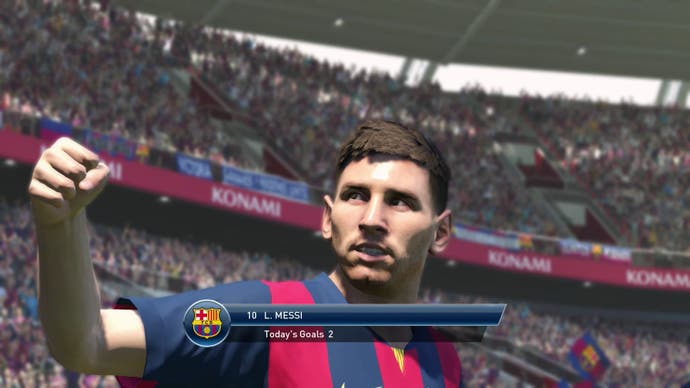
Yes, I might have gone over the top with the Marxism. But - the point stands, that Ultimate Team is the "glamour" which PES traditionally ignores. Which makes PES 2015, and the addition of the Ultimate Team-like myClub (the horrific stylisation is Konami's own) a significant departure. It's hard to get a sense of how a fully-functioning, post-release myClub will play, but the basics are clear. It's a fantasy team-building mode based around the acquisition of graded players that's like Ultimate Team in two crucial ways: the facilitation of microtransactions, enabling players to shortcut their way into new signings by thrusting hands in pockets, and the inclusion of randomisation with regard to which specific player will be signed.
These are the core things which make Ultimate Team a money-spinner, a Skinner Box random reward system wired up to a credit card. There's nothing inherently wrong with that, or any sign that PES 2015's implementation is any more concerning than FIFA's, although it is more idiosyncratic. New signings can only be made using agents (truly, PES is embracing that Premier League-ification) and these agents come with both different ratings, effecting the quality of player they can return, and different specialisations, making them better at finding players of certain nationalities, positions, ages, and so on. Agents are bought with in-game currency (which can also be bought with real money) and the more agents you despatch to a particular negotiation, the better your chance of finding a player that matches your specification. You'll always sign a player, but which one (as revealed on a Lottery draw-style screen of horizontally cascading footballs) depends on the resources you spend, and a bit of chance.
It's a typically convoluted bit of PES logic, especially compared to the playground intuition of FIFA's tiered pack openings (from which PES seems at almost comic pains to distance itself). But it works, at least at the simple level of buying players and slotting them into a team. The real test, though, will be whether it can hold my interest until 2020, when the stands of Europe ring out with the heroic chants of the Palace faithful ("OH SOUTH LONDON...") and the impossible, youthful figure of Dirk Kuyt the Second terrorises defences from the base of the frozen Urals to the salty fringe of the deep Atlantic.
And I'm not even a Palace fan. Thanks, Bradbury.
